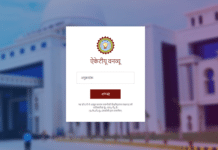It is said that “A good education is a foundation for a better future.”
But, ever since the world was struck with the deadly COVID-19 pandemic, more than learning we are asking questions like “Am I audible?”, “Is my screen visible?” Those who were using the smartphone and other gadgets earlier to just enjoy having conversations, watch an interview, or watch a film have had to forcefully switch to the newer concept of ‘Online Education’, popularly known as ‘E-Learning’ ever since the pandemic before it separated them from reality.
Online Education is like a double-edged sword; it cuts both ways. Online classes work on the assumption that every student has fast access to the Internet, a laptop or smartphone, or even a reliable electricity connection. However, the reality is that out of the 1.2 billion people in India, approximately 600 million have the access to internet facilities. Since everyone cannot afford the expensive internet facilities, some parents are compelled to put a brake on their children’s education. Also, the falling economy of India has provided a boost in illegal and harsh activities like child labor, child trafficking, and daily abuse.
Not just this, interrupted power supply, weak or non-existent internet connectivity, and unaffordability to buy necessary devices like mobile phones or laptops are major concerns. For example, if there are 60 students in a class, after some months of online classes, around 40 students may regularly attend class with whatever device and connection they have. Around 10- 20 students will remain completely absent and the numbers may vary every day. There are network issues on both teachers’ and students’ ends.
Another barrier causing inaccessibility to online education is that the vast majority of learning materials (videos, presentations, and documents) are in the English language, which only 10% of the Indian population fully understand. Companies like BYJU’S, Unacademy, and Vedantu should create content that can be understood in major languages like Hindi, Bengali, Marathi, Tamil, Malayalam, and Telugu to increase the spread of education and make the children feel proud of their language. It will also help them be more confident in life.
Last but not the least, approximately 70% of the students with disabilities had issues regarding the availability of study material. Also, around 80% of their teachers were agitated about teaching effectively without the use of touch to students with learning disorders, autism, and lack of vision. The lack of a constructive education system may further increase the high dropout rates of these children from schools.
In conclusion, the issue of inaccessibility to online education is very serious and needs extra attention. Online education opens up a lot of possibilities for students and teachers alike. Yet, if not acted upon, it may also widen the socio-economic inequalities of India. All the policies and regulations with regard to online education should strive to be inclusive. A proper vision, effective steps, and a positive attitude towards change are necessary to bring a change in Indian education. Although removing the two letters ‘i’ and ‘n’ from the word ‘inaccessibility’ is very tough but, it is necessary that we don’t just put all the responsibility on the government and criticize them rather, on the grass-root level, we should ensure that every child is able to acquire knowledge that he/she deserves.




















